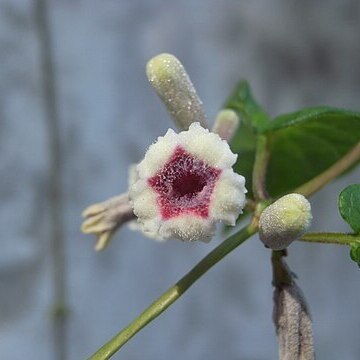Straggling or climbing usually foetid-smelling shrubs, with mostly slender flexuous stems, more rarely suberect. Leaves mostly petiolate, opposite or in whorls of 3; stipules intrapetiolar, ovate to narrowly triangular, not divided into lobes or sometimes bifid where forming bracts at base of inflorescence, deciduous. Flowers mostly rather small, usually pedicellate, rarely subsessile, not heterostylous, in axillary or terminal branched cymes or panicles, or in fascicles. Calyx-lobes 4–5, triangular or subulate, persistent. Corolla-tube cylindrical, campanulate or narrowly funnel-shaped, the throat glabrous or hairy, the base often split for a short way into 5 parts separated by dense hairs giving a characteristic appearance; lobes 4–5, short, narrow or broad, induplicate-valvate, often hairy and sometimes margined. Stamens 4–5, inserted in the corolla-tube, the anthers either included or exserted, often at unequal heights; filaments mostly very short. Disc usually hemispherical. Ovary 2–3-locular, with a solitary erect ovule in each locule; styles filiform, free or joined; stigma-lobes 2–3, filiform, included or exserted. Fruit globose or compressed-ovoid or-ellipsoid, with a thin brittle usually shiny epicarp, splitting into 2–3 round or elliptic 1-seeded pyrenes which are dorsally compressed, marginally winged or not, membranous to coriaceous, and at length often pendulous from a detached rib-like external main nerve. Seeds the same shape as the pyrenes and intimately associated with them, dorsally very compressed, with fleshy albumen and large embryo bearing cordate leafy cotyledons.
Fruit subglobose to compressed-ovoid or-ellipsoid; exocarp thin, papery and brittle, at length breaking open and falling off, exposing 2(3) round to elliptic, laterally compressed and often distinctly winged 1-seeded pyrenes which are pendulous from a detached persistent median vein.
Corolla tube cylindrical to narrowly campanulate, hairy inside, base often splitting into 4–5 parts; lobes 4–5, shorter than tube, valvate in aestivation.
Ovary 2(3)-locular, with a solitary erect ovule in each chamber, crowned by a small disk; styles filiform, free or joined; stigma lobes 2(3), filiform.
Seed compressed, similar in shape to unwinged part ofpyrene; testa thin; endosperm copious, embryo large, with conspicuous cordate cotyledons.
Stamens 4–5, inserted near or at mouth of corolla tube, anthers included or exserted and usually at different heights; filaments short.
Flowers in axillary or terminal thyrsoid inflorescences, or solitary.
Leaves usually petiolate; stipules entire, ± triangular, deciduous.
Shrubs, mostly climbing, foetid-smelling.
Calyx lobes 4–5, persistent.

